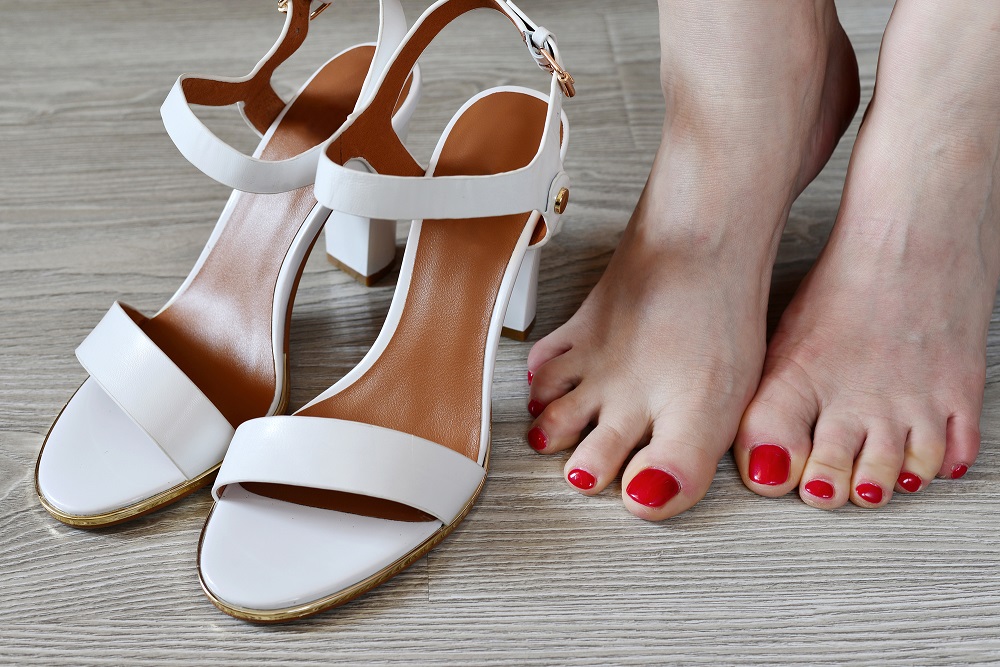The Dangers of Flip-Flops and High Heels

By Damian Roussel, D.P.M., Mid-Maryland Muskuloskeletal Institute care center
Summer is nearly here, and with it comes warmer weather and time for a new wardrobe. When picking out a pair of shoes, there’s actually a lot to consider with regard to your health. You may be aware that flip flops and high heels can cause harm to your feet, but do you know why? Let’s review some ways these types of shoes can lead to injuries and why.
Sandals and Flip-Flops
Choosing to wear a pair of flip flops or sandals can expose you to infections due to lack of protection. Sandals and flip flops made from porous materials retain water and harbor viral and fungal bacteria, and can cause infections like athlete’s foot and warts. I would recommend a sandal made of plastic material that does not retain water to reduce this risk. Unsightly bunions, callouses and painful blisters can also form from the straps on sandals and the lack of support they provide.
Walking in sandals can alter your posture, slow down your gait and make you clumsy. Short strides and an awkward step can cause you to trip and fall, which can lead to a slew of other injuries. The shoes may also cause hammer toes, a deformity in which the toe is permanently bent downwards. Hammer toes can be corrected with a surgical procedure to shorten and straighten the toe, but refraining from wearing sandals may help to prevent this condition.
Did you know that sandals and flip flops can impact your body beyond your foot and ankle? Wearing sandals can aggravate your joints and cause pain or injury, as they don’t provide the support necessary to keep your body aligned. Poor alignment can ultimately lead to increased pain in the knees, hips and lower back.
Unfortunately, many people are drawn to wearing sandals in the summer months, but some types of sandals are safer than others. When you are shopping for sandals, make sure you pick a shoe that fits properly. If your sandal is too big, you’ll have an increased risk of tripping. If it is too small, your toes may hang off the front of the shoe and are then exposed and can be damaged. The shoe should have a supportable, moldable foot bed. These shoes are often marketed as “orthotic sandals.”
Avoid flat, foam sandals and sports sandals. I also recommend that you search for wider straps to avoid blisters and to provide more stability. Additionally, you may want to disinfect your sandals and let them sun dry every few weeks. You can use a common disinfectant like Lysol or Clorox. This will keep them fresh and less likely to carry bacteria.
High Heels
Women can sustain a number of injuries as a result of wearing heels. We’ve all seen women teetering about in sky-high heels, and that instability can cause women to fall or sprain an ankle, which can require a long recovery time. Increased pressure to the ball of the foot causes the fat pad (the thick pad of connective tissue that runs under the foot) to wear out. Wearing narrow-toed high heels or heels higher than two inches can also cause painful pinched nerves called Morton’s Neuromas, a thickening of the nerve that supplies sensation to the toes. This is a very painful condition that can require a surgical procedure to relieve the pain. High heels can also cause hammer toes, blisters and callouses because of the shape of the shoe, and can lead to joint pain because heels have no shock absorption.
Deformities to foot and muscle structure are common when wearing heels as well. For example, the Achilles Tendon can shorten because of the raised heel, and when women remove their heels at the end of the day, the tendon quickly stretches out, which can cause Achilles Tendonitis and heel pain.
Choosing the right pair of high heels may lower the risk of injury or pain. Ideally, opt for a lower and wider heel. I wouldn’t recommend a heel higher than two inches – and look for a wider heel base that makes the shoe more stable to reduce the risk of tripping or twisting your ankle. Consider shopping at a store that fits you for the right high heel. Work with a sales representative to make sure the shoes are comfortable in the store, and if you later find they are uncomfortable, return the shoes rather than bearing the pain.
Some extra advice for women who frequently wear high heels: pack an additional pair of shoes. Whether driving, walking or taking the subway when commuting to work, wear comfortable shoes during the commute and change when you get to work to minimize time spent wearing heels.
It is unlikely that high heels or sandals will go out of style this summer. Fortunately, there are steps you can take to reduce the risk of injury or irritation. Be smart about your shoe choice to improve your foot and ankle health.
Dr. Damian Roussel is board certified in both foot surgery and reconstructive rearfoot and ankle surgery by the American Board of Foot & Ankle Surgery. A podiatrist, Dr. Roussel has expertise in advanced ankle arthroscopy, ankle ligament reconstruction, Achilles Tendon repair, joint replacement, fracture care, sports injuries and more. Dr. Roussel received his medical degree from Temple University School of Podiatric Medicine in Philadelphia, Pa., and completed his residency at The University of Pennsylvania.
Learn more about related foot conditions:

